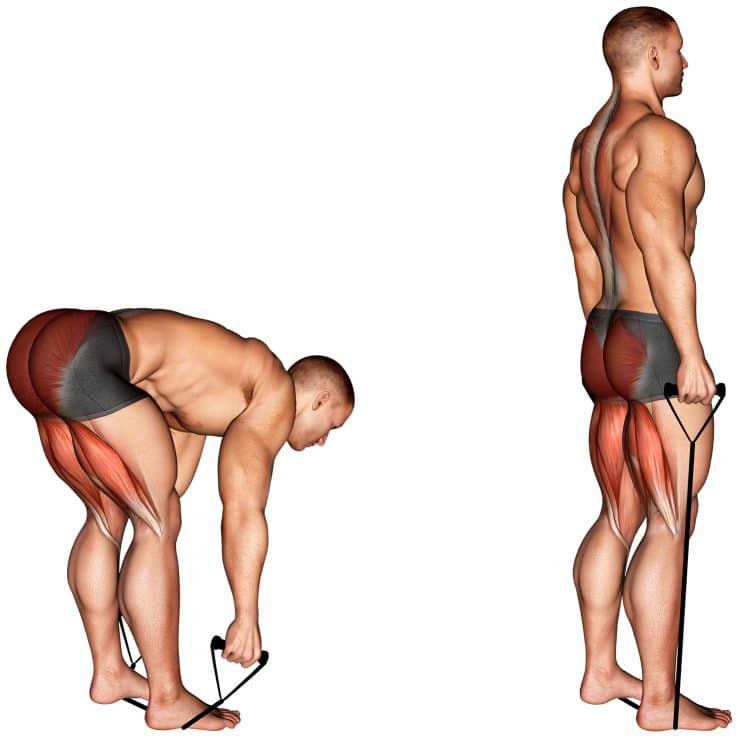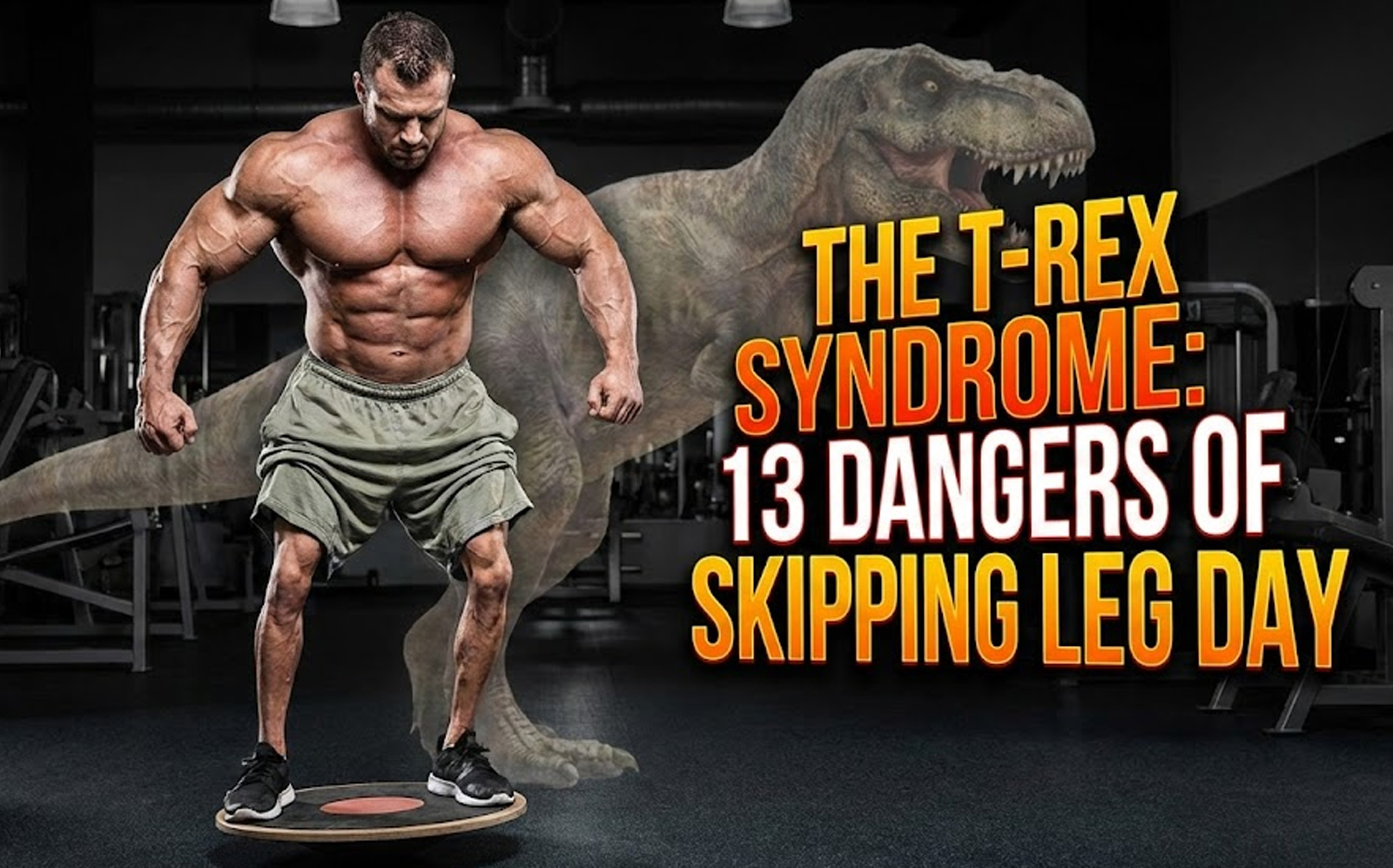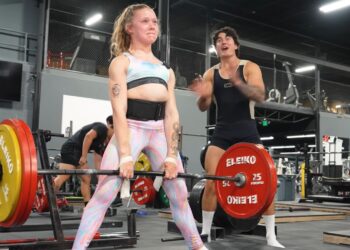Band stiff legged deadlifts (BSLD) are a weighted lower body exercise variation using band technology to create strength and muscle gains in the glutes, hamstrings, lower back, lats, and calves. A modification of conventional deadlifts, BSLDs are less taxing on the nervous system, and you won’t feel as drained after training, as there’s less total body power recruitment, and it’s geared more toward hypertrophy and precision.
But athletes can use this exercise to improve explosive performance, and strength while creating more resilient hamstrings, and likely preventing sports-related injuries.
This guide will go over the advantages of band stiff legged deadlifts, common mistakes, variations, and alternatives of this beginner-friendly posterior pull technique.
Muscles Worked During Band Stiff Legged Deadlifts
A complete backside movement, learn about the muscles worked in this posterior focused technique.
- Gluteus maximus – A primary recipient of deadlift gains, your rump is on the frontline of posterior-focused action. And while your butt is three muscles in one, the gluteus maximus is larger, stronger, and more prominent than its younger siblings. Creating the size and shape of your hip and butt. But it doesn’t just look good in fitted leggings, your rear end straightens the hips (Like when you stand up), rotates it outward, and swings the leg in and out.
- Erector spinae – A three parts muscle group, erector spinae fibers lie the length of your entire upper back, reaching from the pelvis all the way upward to the occipital bone (Bony bump in the back of the head). These muscles take care of vertebral movement such as bending and straightening the spine in various directions.
- Hamstrings – The hamstrings use three muscles in the rear thigh to bend the knee and extend the hips, like during a lying leg curl, or popping up out of a squat, respectively. Deadlifts are one of the best lifts for building pure hamstring strength.
- Adductor magnus – Unique is a word to describe the adductor magnus. A large and mighty muscle simultaneously latched onto the medial and rear thigh, hence serving roles for the lower body such as moving the thigh inward, thigh flexion, and thigh extension.
In This Exercise:
- Target muscle group: Backside of the body
- Type: Hypertrophy
- Mechanics: Isolation
- Difficulty: Intermediate
How To Do The Band Stiff Legged Deadlift
Deadlift variations occur from the hip joint, and not the knees, like a squat, for example. Therefore, if you can remember to keep the legs long, and back neutral, you’ve already got most of the movement down pat.
Level Up Your Fitness: Join our 💪 strong community in Fitness Volt Newsletter. Get daily inspiration, expert-backed workouts, nutrition tips, the latest in strength sports, and the support you need to reach your goals. Subscribe for free!
Steps
- Stand evenly on your band with feet roughly hip width apart. Make sure the ends are even to avoid muscle asymmetries.
- Keeping your back straight and core tight, bend your knees, drop down, then grip the bands in both hands. Grab the band low enough so it’s stretched when you’re standing upright.
- Stand up straight in the starting position.
- Now, with your torso neutral, chest up, knees softly bent, and core engaged, hinge forward from the hips until your back is roughly parallel to the floor.
- Then drive your arches into the floor, and push your hips forward while lifting your torso upright. Don’t overextend the lower back.
- Repeat for the desired number of repetitions.
Tips
- Keep in mind, your limb length and body proportions can affect your range of motion. Try to get your torso as parallel as possible, however, don’t force anything that feels uncomfortable or painful. It could also take time for your body to adapt into greater ranges of movement.
- We recommend using high quality resistance bands, as you should with any exercise.
Benefits of The Band Stiff Legged Deadlift
Stiff legged deadlifts are different from conventional deadlifts because they require a different focus which should yield unique results.
A nicer backside!
Stiff legged deadlifts involve a lot of gluteus maximus, or the largest butt muscle that comprises the shape and look of your derrière. In one study, the stiff legged deadlift was compared to the Romanian deadlift which is no doubt a more popular type of deadlift, especially by your average gym-goer (1).
Well, it turnt out that the stiff legged version was more potent for activating the gluteus maximus. And because both exercises are focused more on precision, and getting those deep posterior fibers, if choosing between the two, the stiff legged deadlift is probably the better option for faster booty gains!
Great for athletes
Three of the most powerful performance muscles, gluteus maximus, hamstrings, and calves are conveniently located along the backside of the body. While they have different functions, you may have noticed that they contribute to the same joints to strategically carry out athletic movements. Therefore, it’s in your best interest to train these muscles hard, heavy, explosively, and most importantly safely for optimal performance.
A better deadlift, less fatigue
The conventional deadlift is an all out lift, using optimal body mechanics to get every possible advantage you need to pick up the oftentimes maximally loaded bar. While the quadriceps, core, and upper back muscles will be much more required during a standard deadlift, the erector spinae, glutes, hamstring, and calves must also be in tip top shape, and contribute a lot to your strength performance.
SLDLs are a great compliment to your deadlifts in that they strengthen these muscles without the full commitment, and hence effort of an all out deadlift. Which can be very taxing, and exhausting.
Stand taller
Posture is so important not just because it’ll make you look more confident or attractive. A hunched over stance or poor lifting posture has many negative side effects. These include making you less aesthetic, weakening the neck muscles, affecting your spine and shoulders and causing you to have the appearance of a protruding stomach, while increasing risk for thoracic outlet syndrome (TOS).
TOS is a condition where the nerves and blood vessels in your upper extremity become compressed between the collarbone and first rib. This results in feeling pain, numbness, and weakness.
Prevent hamstring injuries
Especially necessary for athletes or highly active people, loading the hamstrings while they’re in a stretched position may significantly decrease the risk of activity related injuries (2).
Common Mistakes During Band Stiff Legged Deadlift
These tips are especially helpful for beginner just starting out with learning the mechanics of deadlift type movements. Try to veer away from ever making these common mistakes.
Too much knee bending action!
Might as well go for the standard deadlift or squat if you’ll be involving too much knee which will shift emphasis to your quadriceps, hence defeating the purpose of the hip hinge, posterior focused stiff legged deadlift.
The solution: We recommend filming yourself from the side, or asking someone well versed in deadlift style exercises to coach you through the technique. Additionally, you should feel the glute and hamstrings stretching, which means you’re on the right track!
Level Up Your Fitness: Join our 💪 strong community in Fitness Volt Newsletter. Get daily inspiration, expert-backed workouts, nutrition tips, the latest in strength sports, and the support you need to reach your goals. Subscribe for free!
Dumping resistance at the bottom
You were doing great until you decided to let it all go at the bottom. And that has to do with how you set up. Because when you bend forward, the band should still be stretched with tension. You’re not grabbing the band low enough (Recommended), or spreading your feet far enough. Although your stance should be your normal deadlift stance, and it should be comfortable and optimal for performance. So more times it’s how low you grab.
Rounding the back
A rounded back isn’t always a bad thing when doing a deadlift. In fact, you almost need to when trying to hit prs. However, a band stiff legged deadlift doesn’t call for this. Therefore, follow the advice of keeping a straight back to effectively activate the hamstrings and erector spinae.
Too much hyperextension
Band stiff legged deadlifts are not hyperextensions. And it’d be unnecessary to over arch the back. Although full extension is recommended for this exercise which means training through a full range of motion.
Variations and Alternatives of Band Stiff Legged Deadlifts
Deadlifts come in many variations that carry their own advantages over the others. But it’s always healthy to include more options in your training lineup both for freshness, and shifting the emphasis between various posterior muscle groups.
Try these band stiff legged deadlift variations and alternatives!
Band stiff legged single leg deadlift
We’re all in favor of one legged variations of any movement that makes it possible. Nut what are the benefits you can gain from unilateral exercise? If you can stand on one leg and train, you’ll pinpoint left to right asymmetries, oftentimes feel stronger muscle contractions, and benefit from functional balance training.
Related: The 5 Best Unilateral leg exercises
Band Romanian deadlift
After conventional deadlifts, Romanian deadlifts (RDL) are probably the most popular variation. There are similarities between RDL and SLDL, although they are used for different purposes. But when training with bands, you won’t realize how much they contrast like when using a barbell.
Learn more: Romanian deadlift vs. stiff legged deadlift
Free weight stiff legged deadlift
The default method for all things deadlift and the standard by which strength and records are measured, because there’s no rawer way to train than with a barbell and dumbbells. There’s no railing or fixed structures to do the stabilizing for you, which has not just strength benefits but it’ll improve mental fortitude simultaneously. Free weight stiff legged deadlifts are a top notch overall variation.
Cable/machine stiff legged deadlift
A step up from band stiff legged deadlifts, cables offer an immediate greater challenge overall, due to the same degree of difficulty from start to finish. Unlike a resistance band that has to stretch for you to feel challenged. Although more experienced exercisers know how to best maximize bands.
Steps
- Slide the cable pulley down low to the bottom of the machine.
- Secure a D-handle or rope attachment. Then select a light weight to do a few practice reps.
- Grab the handle in both hands.
- Step back away from the machine to create tension, and give yourself space to perform the movement.
- Stand with your feet roughly shoulder width apart and keep your legs long.
- Keeping your back straight, move your butt back, and hinge forward at the hips until your torso is roughly parallel to the floor.
- Now shoot the hips forward while simultaneously pulling the handle toward you. Squeeze the glute muscles hard, then push the hips back and repeat.
- Complete as many repetitions as you need to.
Good mornings
There doesn’t seem to be much difference between stiff legged deadlifts and a good morning, as they do essentially the same thing. And aim to target the same muscle groups.
You could replicate the standard barbell good morning by anchoring a looped band with your feet, and wrapping it over your neck.
FAQ’s
What set and rep range should I aim for?
It depends on your training goals. However, anyone who includes band stiff legged deadlifts must be sort of serious about their training.
Therefore, we’d recommend 2-4 sets of 8-15 reps per workout, alternating lower and higher intensity sessions for the best of both strength and muscle gains.
Do I need a special type of band for this exercise?
The good news is that most types of resistance bands will work just fine. You can use a single band, two lopped bands (One for each foot), or any quality standard length options.
What's the difference between a stiff legged deadlift and regular deadlift?
Stiff legged deadlifts are more of an isolation technique involving reduced muscle power and more focus. It’s less taxing on the body in comparison to a conventional deadlift which requires higher muscle recruitment and strength focused mechanics.
Learn Everything About Deadlifts.
Wrapping Up
On those lower intensity training days, the band stiff legged deadlift will fit your agenda like a glove. Perfectly suited for the beginner trainee learning to perfect their hip hinge, this variation has tons of progressive benefits. Including aesthetic improvements to your butt, hamstrings, lower back, calves, and lats, but without having to exert as much total muscle energy as you would in a regular deadlift.
And if you want something similar without using bands, hop on over to the one of the popular variations and alternatives also recommend in this exercise guide.
References:
- Coratella G, Tornatore G, Longo S, Esposito F, Cè E. An Electromyographic Analysis of Romanian, Step-Romanian, and Stiff-Leg Deadlift: Implication for Resistance Training. Int J Environ Res Public Health. 2022 Feb 8;19(3):1903. doi: 10.3390/ijerph19031903. PMID: 35162922; PMCID: PMC8835508.
- Raya-Gonzalez J, Castillo D, Clemente FM. Injury prevention of hamstring injuries through exercise interventions. J Sports Med Phys Fitness. 2021 Sep;61(9):1242-1251. doi: 10.23736/S0022-4707.21.11670-6. Epub 2021 Jan 22. PMID: 33480508.
Interested in measuring your progress? Check out our strength standards for Good Morning, Stiff Leg Deadlift, Lying Leg Curl, and more.









